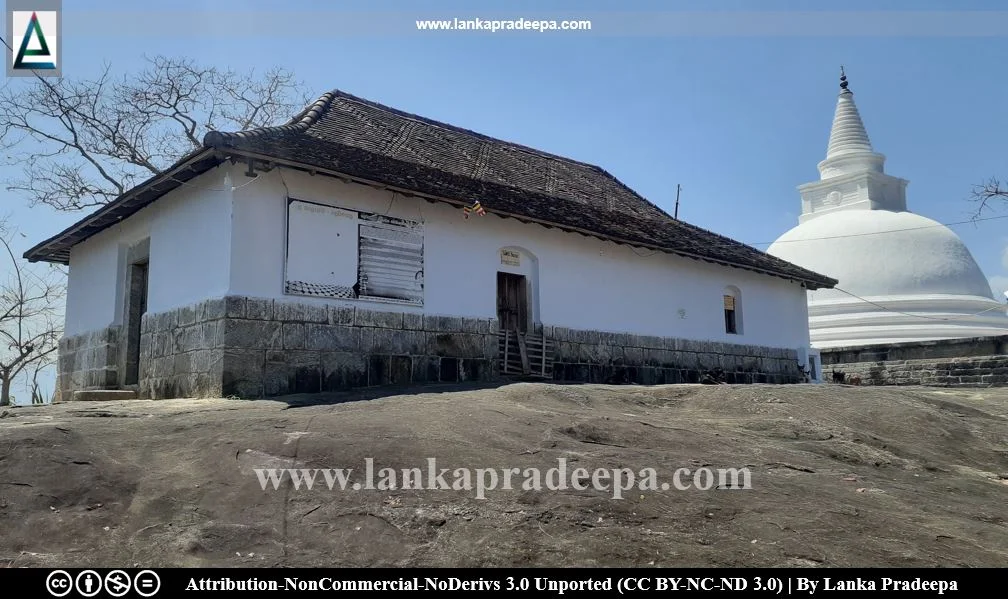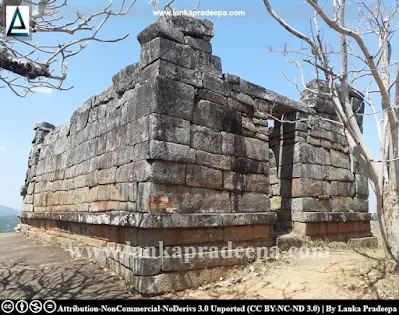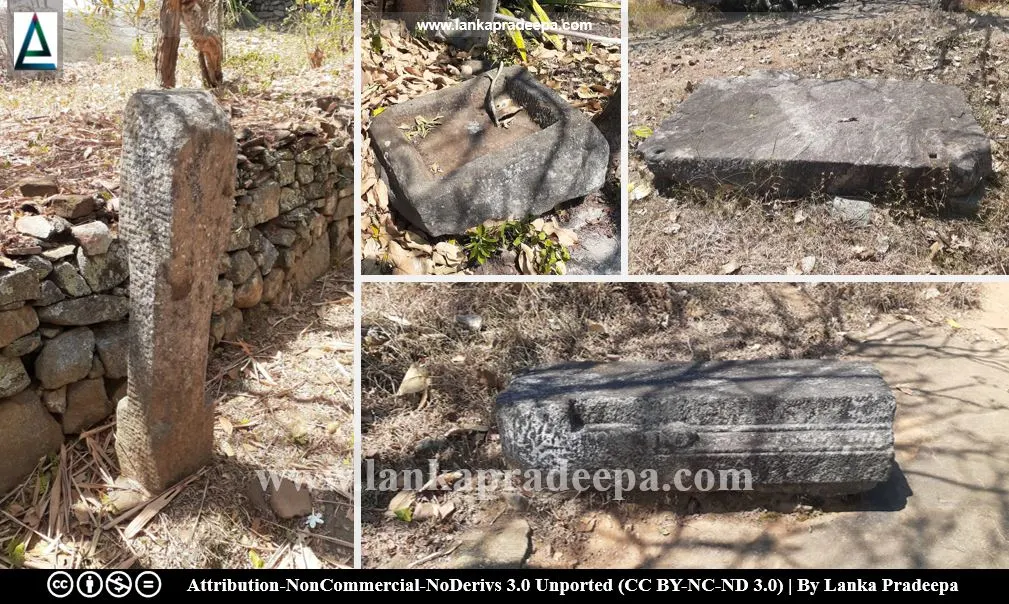
Devanagala Raja Maha Viharaya (Sinhala: දෙවනගල විහාරය) is a Buddhist temple situated in the Mawanella area in Kegalle District, Sri Lanka.
Folklore
This site is called Devanagala because it is believed by the folk that this is the place that the deity Dedimunda visited for the second occasion. In the Sinhalese Language, the word Devana means second and Gala means rock. However, another theory suggests that it is so named because it is the second-largest rock in the area after the Bathalegala rock.
History
 The history of Devanagala is expanding from the Prehistoric Period to the Kandyan Period. Archaeological evidence dating back to the prehistoric period has been found at the site (Aregama, 2018).
The history of Devanagala is expanding from the Prehistoric Period to the Kandyan Period. Archaeological evidence dating back to the prehistoric period has been found at the site (Aregama, 2018).
The Buddhist temple on the Devanagala rock is believed to be the Dasen Vehera built during the reign of King Dhatusena (460-479 A.D.) of the Anuradhapura Era (Aregama, 2018). However, the Devanagala inscription by King Wimaladharmasooriya I (1592–1604 A.D.) says that the monastery on this rock was founded in 2110 B.E. (1566 A.D.) by a Buddhist monk named Ratanalankara (Ranawella, 2015).
The Tempita Viharaya of Devanagala temple is said to be constructed during the Kandyan period by King Wimaladharmasooriya I (Abeyawardana, 2002). It is believed that the sacred Tooth Relic of the Buddha was kept in the Devanagala temple secretly for three months (Abeyawardana, 2002).
The Tempita Viharaya of Devanagala temple is said to be constructed during the Kandyan period by King Wimaladharmasooriya I (Abeyawardana, 2002). It is believed that the sacred Tooth Relic of the Buddha was kept in the Devanagala temple secretly for three months (Abeyawardana, 2002).
Monuments
Several Buddhist monuments including an old Buddha shrine (Gal Viharaya or Parana Viharaya), a Tempita Viharaya (the temple on pillars), a Stupa, a preaching hall, a Siri Pathula (the footprint of the Buddha), a pond, and a Bodhi-tree are found in the present temple premises (Silva et al., 2016). Mainly two rock inscriptions, one dating back to the Polonnaruwa Period and the other to the Kandyan Period have also been found (Silva et al., 2016).
Inscriptions
Devanagala rock inscription of Parakramabahu I
Among the two inscriptions found in Devanagala, the one that belongs to the Polonnaruwa Period is considered a very important record (Paranavitana, 1933). It mentions a grant of a village by King Parakramabahu the Great (1153-1186 A.D.) to a military chief named Kit-nuwaragal Senevi (Kitti Nagaragiri) who succeeded in a war against Myanmar (Paranavitana, 1933).
Reign: Parakramabahu I (1153-1186 A.D.)
Period: 12th century A.D. Script: Mediaeval Sinhala Language: Mediaeval Sinhala
Content: On the orders of King Parakramabahu the Great, General Kit Nuwaragal invaded the city of Kusumiya in Ramannya Desa (present-day Pathein in Myanmar). To commemorate this victory king granted land in the extent of twelve Amunas and two Pelas from Malabatuva and Kitsen Pawwa, as permanently owned lands and this decree is effective until the sun and moon last
Reference: Paranavitana, 1933; The information board at the site by the Department of Archaeology and the Ministry of National Heritage.
Devanagala rock inscription of Wimaladharmasuriya I
The second inscription belongs to the reign of King Wimaladharmasooriya I, but it refers to the year 2110 Buddhist Era (1566 A.D.) in connection with the foundation of the Devanagala Viharaya at the site by a Buddhist monk named Ratanalankara (Ranawella, 2015).
Reign: Wimaladharmasooriya I (1591-1604 A.D.)
Period: 16-17th centuries A.D. Script: Modern Sinhala Language: Modern Sinhala
Content: The foundation of a monastery on this rock in 2110 B.E. by Ratanalankara and the benefactions made to it (grant of some land, a village named Ruwandeniya with its adjuncts) by King Wimaladharmasooriya I is recorded in the inscription.
Reference: Ranawella, 2015.
Tempita Viharaya
Tempita Viharas (the temples on pillars) were a popular aspect of many Buddhist temples during the Kandyan period. These structures were usually built on a wooden platform resting on bare stone pillars or stumps which are about 1-4 feet tall. The roof is generally made of timber and held by wooden stumps. The walls are usually made of wattle and daub and they form the main enclosed shrine room containing the Buddhist sculptures and murals belonging to the Kandyan style. Some Tempita Viharas have narrow verandas and ambulatories circulating the main enclosed space. The construction of these buildings started in the 17th century and lasted until the end of the 19th century (Wijayawardhana, 2010).
Devanagala Tempita Viharaya
The Tampita Viharaya of Devanagala temple belongs to the Kandyan Period. A seated statue of Buddha underneath an elaborate Makara Thorana (the Dragon Arch) is found inside this shrine. One statue of Buddha and two statues of deities stand beside the seated Buddha. Two seated statues of Buddha are also found facing each other on both the left and right walls. Presently, a new building has been built surrounding this Tempita Viharaya.
A protected site
The government notification: 12 December 1941.
The ancient Buddha shrine, sculptures, inscriptions, paintings and all other ruins at the premises of Devanagala Rajamaha Vihara situated on the Devanagala rock in Devanagalagama village in the Divisional Secretary’s Division, Mawanella are archaeological protected monuments, declared by a government notification published on 12 December 1941.
The gazette notification: 4 June 2004.
The Devanagala rock where the ancient Devanagala Raja Maha Viharaya located is an archaeological protected site, declared by a government gazette notification published on 4 June 2004.
The ancient Buddha shrine, sculptures, inscriptions, paintings and all other ruins at the premises of Devanagala Rajamaha Vihara situated on the Devanagala rock in Devanagalagama village in the Divisional Secretary’s Division, Mawanella are archaeological protected monuments, declared by a government notification published on 12 December 1941.
The gazette notification: 4 June 2004.
The Devanagala rock where the ancient Devanagala Raja Maha Viharaya located is an archaeological protected site, declared by a government gazette notification published on 4 June 2004.
The gazette notification: 9 March 2016.
Devenagala rock with the complex of archaeological ruins including Chaitya. Preaching hall, rock inscriptions, hillocks of ruins, walls, ponds, the plight of steps, caves, and places with pre-historic evidence at the premises of Devanagala Rajamaha Vihara belonging to Devanagala, Udapamunuwa, Karahampitigoda, Ruwandeniya, and Katugahawaththa villages situated in Grama Niladhari Division No. 28A, Kekerigoda, No. 33B, Devangala No. 33A, Attapitiya and No. 33C. Ruwandeniya belonging to Divisional Secretary’s Divisions Mawanelle and Aranayaka is an archaeological protected site, declared by a government
gazette notification published on 9 March 2016.



.
Attribution
1) Lord Budhda by Rajindu Prabath is licensed under CC BY-SA 4.0
References
1) Abeyawardana, H.A.P., 2002. Heritage of Sabaragamuwa: Major natural, cultural and historic sites. Sabaragamuwa Development Bank and The Central Bank of Sri Lanka. ISBN: 955-575-077-7. p.79.
2) Aregama, H.M.S.K., 2018. Parakramabahu rajuge Buruma satanata pana pevu Devanagala parvatha lipiya (In Sinhala). Dayada Newsletter. July 2018. 12th edition. Department of Archaeology.pp.31,36.
3) Paranavitana, S., 1933. (Edited and translated by Wickremasinghe, D.M.D.Z.; Codrington, H.W.) Devanagala rock inscription of Parakramabahu I. Epigraphia Zeylanica: Being lithic and other inscriptions of Ceylon: Vol. III. Printed at the Department of Government Printing, Sri Lanka (Ceylon) for the Archeological Department. pp.312-325.
4) Ranawella, S., 2015. Inscriptions of Ceylon. (Vol. IX). Department of Archaeology. ISBN: 978-955-9159-98-8. pp.23-24.
5) Silva, K.T., Niwas, A., and Wickramasinghe, W.M.K.B., 2016. Religious Interface and Contestations between Buddhists and Muslims in Sri Lanka. Colombo: International Centre for Ethnic Studies. pp.7-8.
6) The Gazette of the Democratic Socialist Republic of Sri Lanka. No: 1344. 4 June 2004. p.14.
2) Aregama, H.M.S.K., 2018. Parakramabahu rajuge Buruma satanata pana pevu Devanagala parvatha lipiya (In Sinhala). Dayada Newsletter. July 2018. 12th edition. Department of Archaeology.pp.31,36.
3) Paranavitana, S., 1933. (Edited and translated by Wickremasinghe, D.M.D.Z.; Codrington, H.W.) Devanagala rock inscription of Parakramabahu I. Epigraphia Zeylanica: Being lithic and other inscriptions of Ceylon: Vol. III. Printed at the Department of Government Printing, Sri Lanka (Ceylon) for the Archeological Department. pp.312-325.
4) Ranawella, S., 2015. Inscriptions of Ceylon. (Vol. IX). Department of Archaeology. ISBN: 978-955-9159-98-8. pp.23-24.
5) Silva, K.T., Niwas, A., and Wickramasinghe, W.M.K.B., 2016. Religious Interface and Contestations between Buddhists and Muslims in Sri Lanka. Colombo: International Centre for Ethnic Studies. pp.7-8.
6) The Gazette of the Democratic Socialist Republic of Sri Lanka. No: 1344. 4 June 2004. p.14.
7) The Gazette of the Democratic Socialist Republic of Sri Lanka: Extraordinary. No: 1957/18. 9 March 2016. p.1A.
8) The government notification. No: 8827. 12 December 1941.
8) The government notification. No: 8827. 12 December 1941.
Location Map
This page was last updated on 14 January 2023
A short note for local school students
දෙවනගල විහාරය
දෙවනගල විහාරය ශ්රී ලංකාවේ කෑගල්ල දිස්ත්රික්කයේ මාවනැල්ල ප්රදේශයේ පිහිටි බෞද්ධ සිද්ධස්ථානයකි.
ඉතිහාසයදෙවනගල ඉතිහාසය ප්රාග්ඓතිහාසික යුගයේ සිට මහනුවර යුගය දක්වා විහිදේ. ප්රාග්ඓතිහාසික යුගයට අයත් පුරාවිද්යා සාධක මෙම ස්ථානයෙන් හමුව තිබේ.
දෙවනගල පර්වතය මතවූ විහාරය අනුරාධපුර යුගයේ ධාතුසේන රාජ්ය සමයෙහි (ක්රි.ව. 460-479) ඉදිකල දාසෙන් වෙහෙර බැව් විශ්වාස කෙරේ. කෙසේනමුදු, පළමුවන විමලධර්මසූරිය රජුගේ (ක්රි.ව. 1592-1604) දෙවනගල සෙල්ලිපිය ප්රකාරව පර්වතය මත මෙම බෞද්ධ ආරාමය රතනාලංකාර නම් තෙරුන් විසින් බුද්ධ වර්ෂ 2110 (ක්රි.ව. 1566) කරවා තිබෙයි.
දෙවනගල පන්සලෙහි ටැම්පිට විහාරය මහනුවර යුගයේදී පළමුවන විමලධර්මසූරිය රජු විසින් කරවන්නට ඇතැයි පැවසෙයි. එසේම දන්ත ධාතූන් වහන්සේ මෙම විහාරස්ථානයෙහි තෙමසක කාලයක් පුරා රහසිගතව තැම්පත් කොට තිබූ බවද විශ්වාස කෙරේ.
ස්මාරකපැරණි ගල් විහාරය, ටැම්පිට විහාරය, ස්තූපය, ධර්ම ශාලාව, සිරි පතුල, පොකුණ සහ බෝධිය ඇතුළු බෞද්ධ ස්මාරක ගණනාවක් වත්මන් දෙවනගල විහාර භූමියෙහි දැකගත හැකිය. පොළොන්නරුව යුගයට හා මහනුවර යුගයට අයත්වන ශිලා ලේඛන ද්විත්වයක් ප්රධාන වශයෙන් මෙහි හඳුනාගැනේ.
මහා පරාක්රමබාහු රජුගේ දෙවනගල සෙල්ලිපිය (12වන සියවස)
දෙවනගලින් හමුවන ශිලා ලේඛන ද්විත්වය අතුරින් පොළොන්නරු සමයට අයත් ලේඛනය ඉතිහාසමය වශයෙන් ඉතා වැදගත් කොට සැළකෙයි. රජුගේ නියමය පරිදි රාමඤ්ඤ දේශයේ කුසුමියා (වත්මන් මියන්මාරයෙහි පාතේන් ප්රදේශය) නගරය ආක්රමණය කල කිත්-නුවරගල් (කිත්ති නගරගිරි) නම්වූ සෙනෙවිවරයෙකුට මහා පරාක්රමබාහු රජු (ක්රි.ව. 1153-1186) විසින් මලබටුව හා කිත්සෙන් පව්ව ප්රදේශවලින් ප්රධානය කරන ලද ඉඩකඩම් හා එහි අයිතිය පිළිබඳ විස්තරයක් මෙම සෙල්ලිපියෙහි සඳහන් වේ.
පළමුවන විමළධර්මසූරිය රජුගේ දෙවනගල සෙල්ලිපිය (16-17වන සියවස්)
බුද්ධ වර්ෂ 2110දී රතනාලංකාර නම් තෙරුන් විසින් දෙවනගල මත විහාරයක් කරවූ බවත් පසුව ලකෙහි (ශ්රී ලංකාවෙහි) රජපැමිණි පළමුවන විමළධර්මසූරිය රජු විසින් සිදුකල යම් ඉඩකඩම් හා ඊට අනුබද්ධ ප්රධානයන් පිළිබඳ විස්තරයක් මෙම සෙල්ලිපියෙහි සඳහන්ය.
පුරාවිද්යා ස්මාරක ස්ථානය1941 රජයේ නිවේදනය
මාවනැල්ල ප්රාදේශීය ලේකම් කොට්ඨාශයට අයත් දෙවනගලගම ග්රාමයේ දෙවනගල පර්වතයෙහි පිහිටි දෙවනගල රජමහා විහාර පරිශ්රයේ වූ පුරාණ බුද්ධ මන්දිරය, මූර්ති, සෙල්ලිපි, සිතුවම් හා අනෙකුත් සියළු නටඹුන් 1941 දෙසැම්බර් 12වන දින ප්රකාශයට පත් රජයේ නිවේදනය මගින් ආරක්ෂිත පුරාවිද්යා ස්මාරක ලෙස නම් කොට ඇත.
2004 රජයේ ගැසට් නිවේදනය
පුරාණ දෙවනගල රජමහා විහාරය පිහිටි දෙවනගල පර්වතය 2004 ජූනි 4වන දින ප්රකාශයට පත් රජයේ ගැසට් නිවේදනය මගින් ආරක්ෂිත පුරාවිද්යා ස්මාරක ස්ථානයක් ලෙස නම් කොට ඇත.



